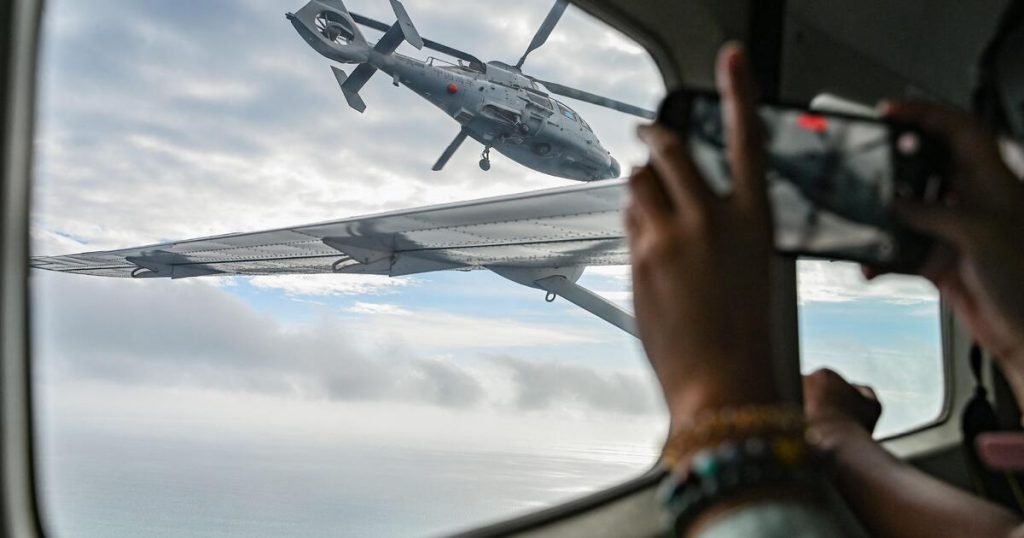Scarborough Shoal Standoff: A Flashpoint in the South China Sea
A Dangerous Encounter in Disputed Waters
Tensions in the South China Sea escalated on Tuesday, February 18, 2025, when a Chinese navy helicopter flew perilously close to a Philippine patrol plane near Scarborough Shoal, a contested territory in the region. The incident unfolded as the Philippine aircraft, a Cessna Caravan turboprop operated by the Bureau of Fisheries and Aquatic Resources, conducted a low-altitude patrol in the area. The Chinese helicopter, identified by the Philippine Coast Guard, came within just 10 feet of the Philippine plane, prompting the Filipino pilot to issue a stern warning over the radio: "You are flying too close, you are very dangerous and endangering the lives of our crew and passengers."
The tense 30-minute standoff, witnessed by an Associated Press journalist and other foreign media onboard the Philippine plane, highlighted the growing animosity between China and the Philippines over Scarborough Shoal. The Philippine pilot repeatedly urged the Chinese helicopter to maintain a safe distance, citing safety standards set by the U.S. Federal Aviation Administration (FAA) and the International Civil Aviation Organization (ICAO). Despite the aggressive maneuvering, the Philippine plane did not alter its course or altitude, refusing to back down from its patrol mission.
China Asserts Claims, Philippines Defends Sovereignty
The encounter is the latest in a series of confrontations between China and the Philippines in the South China Sea, a region of immense strategic and economic importance. Scarborough Shoal, a small but strategically significant coral reef, has been a flashpoint in the dispute. China claims the shoal as part of its territory, referring to it by the Chinese name "Huangyan Island," while the Philippines contends it falls within its exclusive economic zone (EEZ) in the West Philippine Sea.
In a statement following the incident, the Philippine Coast Guard and the Bureau of Fisheries expressed their commitment to upholding Philippine sovereignty and maritime rights in the face of what they described as "aggressive and escalatory actions" by China. The Chinese military, however, accused the Philippine plane of "illegally entering Chinese airspace" without permission and asserted that its actions were necessary to "track and warn" the Philippine aircraft. Senior Col. Tian Junli, spokesperson for the Chinese Southern Theater Command, alleged that the Philippines was "confusing right and wrong and spreading false narratives."
A Decades-Long Dispute with Global Implications
The standoff over Scarborough Shoal is part of a broader territorial dispute in the South China Sea that has persisted for decades. The region, through which more than $3 trillion in global trade passes annually, is claimed in whole or in part by China, the Philippines, Vietnam, Malaysia, Brunei, and Taiwan. The dispute has become increasingly contentious in recent years, with China using coercive tactics to assert its claims, including the construction of artificial islands and the deployment of military assets.
The latest incident coincides with a surge in tensions between China and the Philippines, particularly around Scarborough Shoal and Second Thomas Shoal, where a Philippine navy ship has been anchored since 1999 as a territorial outpost. Analysts warn that the escalating confrontation could have far-reaching consequences, as the United States has a mutual defense treaty with the Philippines, potentially drawing America into a conflict. While most analysts believe a U.S.-China military conflict is more likely to originate from a Chinese attempt to invade Taiwan, the South China Sea remains a critical flashpoint.
Philippines Strategies to Counter China’s Might
Faced with China’s overwhelming military advantage, the Philippine government under President Ferdinand Marcos Jr. has adopted a multifaceted strategy to assert its claims. One approach has been to shine an international spotlight on China’s aggressive behavior by embedding journalists and foreign observers in Philippine sea and air patrols. This "shame campaign" aims to expose China’s actions to the global community and garner international support for the Philippines’ position.
In addition to this diplomatic offensive, the Philippines has sought to strengthen its security alliances with the United States and other Western nations, including Japan, Australia, France, Canada, and the European Union. Manila has also announced plans to acquire advanced military equipment, such as the Typhon missile system from the U.S., to bolster its capabilities in defending its maritime interests. These moves have not gone unnoticed by China, which has warned against an escalating "arms race" in the region and accused the Philippines and its allies of meddling in what it insists is a purely Asian dispute.
Historical Context: The 2012 Standoff and Its Aftermath
The Scarborough Shoal dispute dates back to 2012, when a tense standoff between Philippine and Chinese vessels led to China’s effective takeover of the shoal. Since then, China has maintained a strong naval and air presence in the area, restricting Philippine access to the waters around Scarborough Shoal. In response, the Philippines pursued international arbitration, resulting in a landmark 2016 ruling by a U.N.-backed tribunal. The tribunal invalidated China’s expansive claims in the South China Sea, based on the U.N. Convention on the Law of the Sea (UNCLOS), which both China and the Philippines have ratified.
However, China refused to participate in the arbitration or recognize the ruling, dismissing it as "illegal and invalid." The Scarborough Shoal has since become a symbol of China’s defiance of international law and its determination to expand its influence in the South China Sea. The incident on February 18, 2025, underscores how the dispute remains unresolved and continues to escalate, with both sides digging in their heels and refusing to compromise.
The Broader Implications: Why This Matters Globally
The standoff over Scarborough Shoal is more than just a local dispute; it has significant implications for global security and trade. The South China Sea is one of the world’s busiest and most vital waterways, with billions of dollars’ worth of goods passing through it every year. China’s assertive actions in the region are part of its broader strategy to expand its influence in Asia and challenge the existing global order.
For the United States, the situation is particularly sensitive. As the Philippines’ oldest treaty ally in Asia, the U.S. is obligated to defend the Philippines under their mutual defense treaty if its forces, ships, or aircraft come under attack. While the U.S. has not taken sides in the territorial disputes, its commitment to upholding freedom of navigation and the rules-based international order puts it at odds with China’s aggressive expansion in the South China Sea.
The growing tensions also highlight the South China Sea as a potential front line in the U.S.-China rivalry, which extends beyond territorial disputes to include issues like trade, technology, and global governance. As the situation continues to deteriorate, the need for diplomatic solutions becomes increasingly urgent to avoid a regional crisis that could have far-reaching consequences for global stability.















